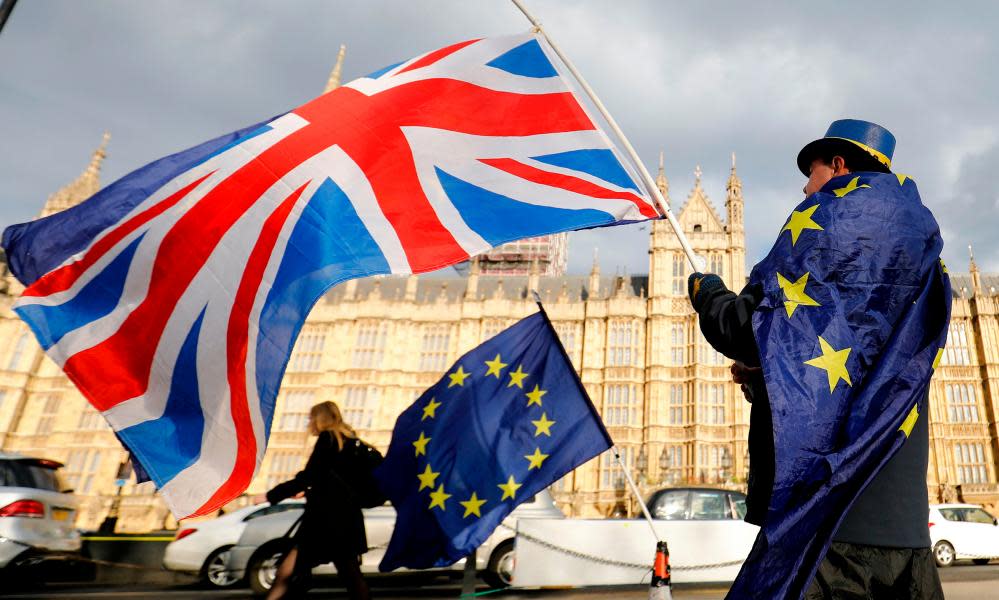Theresa May's draft Brexit deal: what is it and what happens next?

What has happened?
Finally, more than two years after the UK voted to leave the European Union, after torturous negotiations, Theresa May has the draft of an agreement to withdraw from the EU to present to her cabinet, the parliament and the country.
May announced on Tuesday that she had a draft text of the deal, which is said to run to 500 pages. On Tuesday night she summoned those in her cabinet one by one to Number 10 for briefings on the agreement, in what is being seen as a divide-and-conquer strategy. Some among the cabinet, including Andrea Leadsom and Penny Mordaunt, are hard Brexiters, who want the UK to fully exit the customs union, which would limit the UK’s ability to negotiate trade deals with other countries. May has to convince this group to back her version of the deal.
What’s in the deal?
Key elements of the deal began to leak late on Tuesday UK time.
One of the most contentious issues throughout Brexit negotiations has been what to do with the Irish border, which separates the Republic of Ireland (which is in the EU) with Northern Ireland (which is part of the UK and therefore will leave the EU along with the rest of the country). Imposing a “hard border” between the two, with different customs rules has prompted fears that the fragile peace between the two could be shattered.
The UK is understood to have agreed that there will be a UK-wide customs backstop – which is a mechanism to ensure there is no hard border in Ireland after Brexit. This has angered hardline Brexiters.
However, it seems this backstop will be only temporary, with the agreement also saying an independent arbitration committee will judge when a UK-wide customs backstop could be terminated (allowing the UK to move to a free trade deal, stay within the customs union arrangement or extend the transition period). This has caused concern among Northern Irish politicians, some of whom have indicated they will not support the agreement.
Arlene Foster, the leader of the Democratic Unionist party – a pro-unionist party in Northern Ireland that played kingmaker in the 2017 election – said of the Brexit agreement: “An agreement which places new trade barriers between Northern Ireland and Great Britain will fundamentally undermine the constitutional and economic integrity of the United Kingdom. That is not acceptable.”
What’s next?
An emergency cabinet meeting has been called for Wednesday at 2pm, which sources have said is expected to last three hours. They will debate the deal and “decide on next steps”, according to a Number 10 spokesman.
If May secures the support of her colleagues during this meeting, she will then launch a campaign to sell the deal to the country, beginning with a live televised media conference, which escalates this announcement to sit on a par with prime ministerial resignations and national emergencies.
Given that May sometimes struggles as a performer, some have suggested a live conference is not necessarily the best way to sell the agreement to a disillusioned populace.
If the cabinet agrees the plan, the EU expects to hold a special Brexit summit on 25 November. May then takes the deal to parliament, most likely in mid-December.
If they don’t approve it, the UK careers closer to a “no-deal” Brexit, potentially leaving the EU without any agreement reached on important issues such as trade, the status of EU citizens in the UK or UK citizens in the EU.
EU ambassadors had been due to meet in Brussels on Wednesday to discuss the European commission’s no-deal preparations, but the agenda was amended after news emerged of the tentative deal.
Will the deal make it through the UK parliament?
The chief whip said he was confident of getting the deal through. “We are on the cusp of delivering Brexit in a really practical way. She [May] has stuck with it through a really tough year or two,” he said.
However, the divisions in the Conservative party over Brexit and the fact the Conservatives do not have an outright majority and therefore need the support of opposition or minor parties, means this is not a given.
So far no cabinet ministers have resigned over the agreement, as some – including former foreign minister Boris Johnson – did after Theresa May unveiled her plan for Brexit, called the Chequers plan, in July.
Already there are reports that one cabinet minister, Penny Mordaunt, has asked May that ministers be allowed a free vote in parliament, suggesting she was planning to vote against the deal. Hardline Brexiters, such as Jacob Rees-Mogg and Boris Johnson say they plan to vote against the deal because it is too soft. Johnson called the agreement “vassal state stuff”.
Those hoping to hold a second referendum are expected to use the moment of the deal coming before parliament to try to push for it.
It is unclear whether Labour will support the deal, but given Jeremy Corbyn’s statement on Tuesday, this looks unlikely. Corbyn said: “From what we know of the shambolic handling of these negotiations, this is unlikely to be a good deal for the country ... If this deal doesn’t meet our six tests and work for the whole country, then we will vote against it.”

 Yahoo News
Yahoo News 
